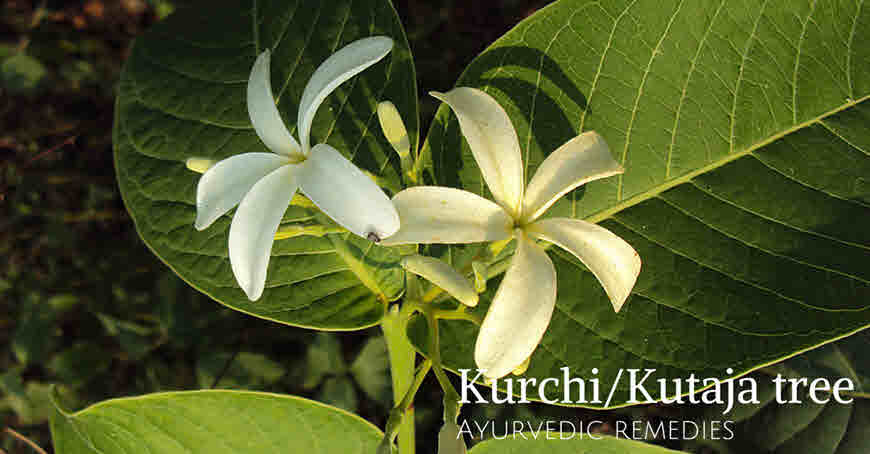Kutaj (Holarrhena antidysenterica Wall) is a glabrous tree or large shrub found throughout the deciduous forest areas of India at low elevations and up to 1100 meters in the tropical Himalayan tract. The seeds of the plant are known as Indrajau or Indrayava. The seeds and stem bark of the tree is indicated in many diseases such as piles, malabsorption symptom and particularly in diarrhea and dysentery. The bark has anti-diarrheal, constipating, astringent, anti-dysenteric, anthelmintic (kills parasitic worms), carminative and digestive properties. The powdered bark when taken in a dose of 3 grams with buttermilk, twice a day gives relief in loose motions. For the medicinal purpose the bark of 8-12 years old trees are collected in July to September and again at the end of winter. Scientific studies have established the anti-protozoal, anti-giardia and anti-amoebic properties of Holarrhena antidysenterica. Read more about Kutaj Ayurvedic remedies.

General Information
Latin name: Holarrhena antidysenterica, Synonyms — Chonemorpha antidysenterica (Roxb. ex Fleming) G. Don, Echites antidysenterica
Roth, Holarrhena antidysenterica (Roxb. ex Fleming) Wall. ex A. DC., H. febrifuga Klotzsch
Family: Apocynaceae
Vernacular names:
- Sanskrit: Kutaja, Girimallikaa, Kaalinga, Kalingaka, Indravriksha, Shakra, Vatsa, Vatsaka, Shakraahvya. Indrayava, Indrabija, Vatsabija (seed)
- Hindi: Indraju, Kurchi, Kuraiya
- English: Ester Tree, Conessi Seeds, Ivory tree, Tellicherry Bark
- Bengali: Kurchi
- Punjabi: Indrajau, Kaurasakh, Kura
- Gujarati: Kuda, Kudo
- Malayalam: Kutakappala
- Marathi: Kudayache Beej
- Oriya: Kurei, Keruan
- Kannada: Kodasige Beeja
- Tamil: Kudasapalai
- Telegu: Kodisapala Vittulu, Palakodisa-Vittulu
- Urdu: Tukhm-e-Kurchi, Indarjao Talkh
- Unani: Inderjo talkh, Teewaaj-e-Khataai
- Siddha: Kudasappaalai-pattai, -vidai (bark, seed)
- Flowering and Fruiting: May-January
- Habitat: Kutaj (Kurchi) or Holarrhena antidysenterica is a plant native to tropical Himalayas. In India, it is found in Indian forests.
Part used
For the medicinal purpose the seeds and bark are used.
The dried seeds are known as Indrayava, Bhadra Yava (Sanskrit), Indraju (Hindi), Kodasige Beeja (Kannada), Kudayache Beej (Marathi) and Conessi Seeds (English).
Main constituents of seeds and bark
Holarrhena antidysenterica Seeds:-
Alkaloids -Steroidal Alkaloid, Conessine, etc., Fats, Tannin and Resin
Holarrhena antidysenterica Stem Bark:-
Alkaloids, regholarrhenine-A, -B, -C, -D, -E and -F;pubescine, norholadiene, pubescimine, kurchinin, kurchinine, kurchinidine, holarrifine, holadiene, kurchilidine, kurchamide, kurcholessine, kurchessine, conessine, conessimine, etc.
Ayurvedic Properties and Action on body
Stem bark:
Rasa (Taste): Tikta/Bitter, Kashaya
Guna (Characteristics): Laghu/Light, Ruksha/Dry,
Virya (Potency): Sheet/ Cool
Vipaka (Post Digestive Effect): Katu/Pungent
Karma/Action: Deepan (Digestive stimulant, the action of kindling agni), Anti-diarrhea, pacifies Tridosha.
Seeds and bark are used therapeutically for: diarrhea, kustha, diarrhea with fever, paasitic worms, malabsorption syndrome, absdominal pain, vomiting or chardi, skin diseases
Ayurvedic Medicines containing Kutaj
Stem bark is the main ingredient in Kutajaristha, Kutajavaleha and Kutaj ghan vati.
Seeds or Indrayava are used in preparation of Piyushvalli Rasa, Pancha Nimba Churna, Laghu Gangadhar Churna, Krimi Kuthar Rasa, Ahiphenasava.
Medicinal use of Kurchi/Kutaja tree (Holarrhena)
Kutaja has bitter, pungent taste and cold in potency. The bark has an astringent, anthelmintic, amoebicidal and diuretic activities and is useful in treating diarrhea, dysentery and amebiasis.
The safe dosage of Holarrhena antidysenterica is as follows
- Stem bark—20-30 grams for decoction
- Stem bark powder- 3-6 gms
- Seed powder-3-6 gms, 20-30 gm for Decoction
Here are few remedies that can be done at home using Easter tree or Kutaja (Holarrhena antidysenterica) to cure various ailments.
Dysentery or diarrhea of chronic nature, Acute dysentery, diarrhea
Kutaj is useful in treating diarrhea, dysentery (atisaar, dast, Sangrahani) and other such digestive system ailments. For treating these ailments you can take Ayurvedic medicine Kutaj Ghan Vati which is prepared from bark of Kutaj. Kutajarishta is also prepared from bark of Kutaj and can be taken in a dose of 15-30 ml with an equal amount of water after the meal. Kutajarishta is useful in treating Grahani (malabsorption syndrome), Pravahika (dysentery), Raktatisara (diarrhea with blood) and Jwara (fever).
If Kutaj bark is available then prepare its powder and take 3-5 g and for children 500 mg to 1 g, twice or thrice daily with warm water, before the meals.
Arthritis, inflammation, pain
Boil bark in water, add salt and apply at inflamed joints.
Take powder of Kutaj bark (10 gm), harad/haritaki (10 gm) and sonth/dried ginger powder (10 gm). Take this powder (1 tbsp) twice a day. This gives relief in pain due to arthritis, gout and joint inflammation. It also improves digestive function. Kutaj causes constipation. So this combination helps in controlling that effect of bark.
Sexual debility, Dhatu rog
Collect the seed (Indrajau) clean them. Dry in shade. Grind to make powder. Mix this powder with Ashwagandha powder in 1:2 ratio. Add misri and take 1 tbsp twice a day for a few days.
Diabetes
Soak Kutaj bark in water at night. Next morning drink this water.
Prameha, Pradar, Skin problem, Kidney stone
Soak bark (2 tbsp) in glass of water at night. Next morning drink this water.
Piles, Fistula
Take its bark powder (2 gms). This is helpful in stopping bleeding in Shonitarsha (Bleeding piles).
Skin problems, Boils, Eczema
Boil its bark in water and wash affected areas.
Precautions while using kurchi/kutaja tree (holarrhena) for medicinal purpose
- In Ayurvedic treatise, there is no mentioned side-effect of Kutaj. Various studies have also confirmed the same.
- Kutaj may cause distension of the abdomen after using for a few days.
- Kutaj is constipating, so as soon as diarrhea is cured, stop using Kutaj or kutaj containing products.
- In high blood pressure, it should be taken under medical supervision.
After loosmotion mucus comes out frequently comes to stool
How get relief from it
Use